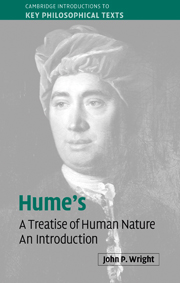Book contents
- Frontmatter
- Contents
- Preface
- Acknowledgments
- List of abbreviations
- 1 The author and the book
- 2 First principles
- 3 Causation
- 4 Skepticism
- 5 Determinism
- 6 Passions, sympathy, and other minds
- 7 Motivation: reason and calm passions
- 8 Moral sense, reason, and moral skepticism
- 9 The foundations of morals
- Bibliography and further reading
- Index
7 - Motivation: reason and calm passions
Published online by Cambridge University Press: 05 June 2012
- Frontmatter
- Contents
- Preface
- Acknowledgments
- List of abbreviations
- 1 The author and the book
- 2 First principles
- 3 Causation
- 4 Skepticism
- 5 Determinism
- 6 Passions, sympathy, and other minds
- 7 Motivation: reason and calm passions
- 8 Moral sense, reason, and moral skepticism
- 9 The foundations of morals
- Bibliography and further reading
- Index
Summary
Hume begins his discussion “Of the influencing motives of the will” (T2.3.3) by noting that most moral philosophy, both ancient and modern, is founded on the idea that there is a “combat of passion and reason,” and that a person is virtuous only in so far as reason is the victor in this combat (T2.3.3.1: 413). On this view, we “ought to oppose” our passions by way of reason. In criticizing this view Hume argues that “reason alone” is impotent, and that therefore it can never act in opposition to our passions. Also, that calm passions are mistaken for reason. To the extent that there is anything like a combat which characterizes our moral life it is really a conflict between “calm passions” and violent ones. But, as we shall see, Hume's own moral theory tends to downplay any such combat. Moral feelings are a subset of calm passions which can, at least in principle, overcome our violent passions “without… opposition” (T2.3.4.1: 419).
The theory that Hume attacks in this section is clearly Platonic. In Book 4 of the Republic Plato wrote of a “civil war of the soul” and argued that it is “appropriate for the rational element to rule” over the spirited and desiring parts of the soul. More directly, Hume is concerned with modern theories such as those of the Newtonian philosopher Samuel Clarke, who wrote that virtue is founded in
the Domination of Reason, and Religion over all the irregularities of Desires and Passions. Every Vice, and every instance of Wickedness, of whatever kind it be; has its Foundation in some unreasonable Appetite or ungoverned Passion, warring against the Law of the Mind.
- Type
- Chapter
- Information
- Hume's 'A Treatise of Human Nature'An Introduction, pp. 216 - 234Publisher: Cambridge University PressPrint publication year: 2009

